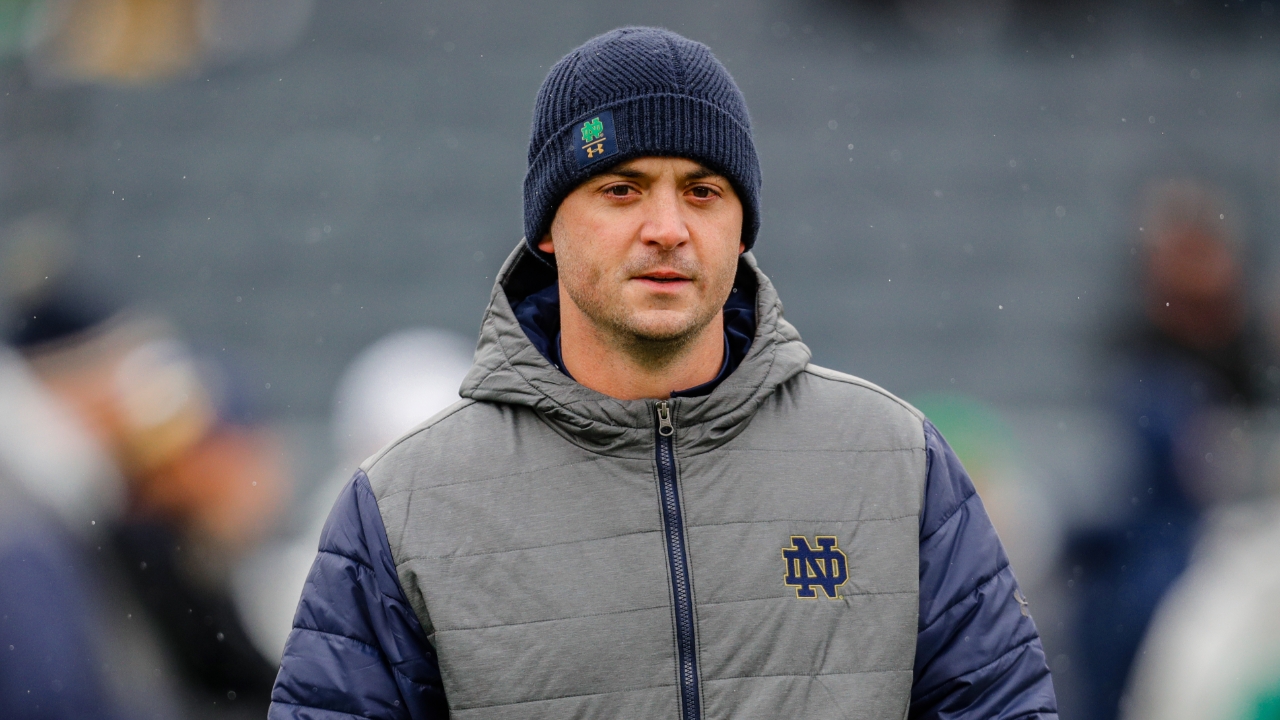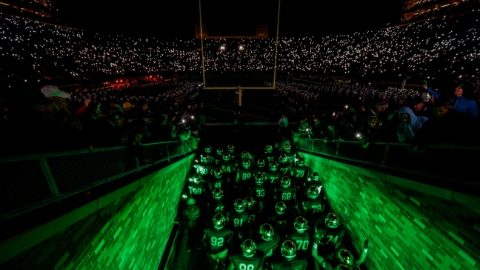
It was a rollercoaster of emotions watching Notre Dame’s offense all season.
They were down. They were up. Some fans probably puked after the Stanford game. They probably puked again in the second half of the Navy game. After all of that, they capped it off with an exciting performance in the bowl game. (So, puke and rally?)
It’s always going to be looked back on as a season of “what if” because of Tyler Buchner’s injury, but we know that things are going to be different in 2023. There’s going to be a new quarterback, whether that’s Buchner or Wake Forest transfer Sam Hartman.
They have to adjust to not having the best tight end in college football. They have to build on what they did well (3rd down, establishing the run) and expand on it. They have to prioritize certain areas to improve and it all starts with being more explosive.
Explosive plays in the running game
Notre Dame found an identity on offense and then really dug into it. They became a run-heavy team, partly because they had to be because of the inconsistency at quarterback and partly because the running backs, tight ends, and offensive line were playing well.
The Irish finished second in stuff rate (percentage of runs for no gain or less) and 11th in average line yards (the yards the line gets credit for).
When I say they leaned into running the football, I mean they really leaned in. They were 14th in run play percentage (59.7%) on the season. It helped them be one of the top teams in time of possession, but it was also something where they grinded out drives rather than something that created big plays.
They only had four runs of 30-yards or more (98th), which is significantly less than Ole Miss and Michigan, two programs who also ran the ball on 60% of their offensive snaps. They each had 14 runs of 30-yards or more (tied for 11th).
Some of this has to do with where they run the football. It was mostly a between-the-tackles running game (60.4% of all designed attempts). Some of it has to do with the personnel. Regardless of the reasons, they have to find a way to be more explosive if they are going to be run-first offense.
The Irish ran it close to the same rate in 2017 (59.5%) and were tied for first in rushes of 30-yards or more.
It’s possible that adding a healthy JD Price and a freshman like Jeremiyah Love could give them a boost with this, but it’s clear that they need to find a way to break longer runs if this is going to continue to be their identity.
More big plays from receivers
I think most people who follow Notre Dame football would be surprised to find out that the passing game was above average when it came to explosive plays. 44th in receptions of 20-yards or more is pretty darn good when you consider the inconsistency at quarterback and Notre Dame finishing 110th in total passing attempts.
Tommy Rees did a nice job of scheming up these plays. Michael Mayer was a big play guy for them (14 receptions of 20-yards or more). The backs had big plays in the passing game as well, highlighted by Logan Diggs’ 75-yard score in the Gator Bowl.
They simply weren’t explosive enough from the receiver position, though. Out of the 48 receptions of 20+ yards, only 19 came from the receiver position. No individual had more than five.
Chase Claypool had 23 in 2019. Will Fuller had 21 in 2015. Miles Boykin had 17 in 2018. Establishing that one big play threat can make a difference.
Lorenzo Styles had four in the first five games of the season and he might have been that guy if not for his issues catching the football. One reason why Notre Dame added Kaleb Smith as a transfer is that he averaged 18.2 yards per reception last season and had 12 catches of 20+ yards. He’s someone who can win on back shoulder attempts and caught 9 of 12 contested targets last season (including 5 of 8 on deep balls).
I think the potential is there at receiver with Jayden Thomas, Deion Colzie, and Tobias Merriweather all capable of producing big plays down the field and if Sam Hartman is the quarterback, he’s been one of the better deep ball passers in college football.
More YAC
This goes hand in hand with the last one. Not all of the big plays have to come on deep balls. Notre Dame needs to be more productive after the catch.
They had 1,467 yards after the catch in 2022. Only 573 came from wide receivers. USC had 2,641 yards after the catch. That’s right at the top of that statistic, but any time there is almost 1,200 yard difference in category between teams and when that one team is your biggest rival, it’s not something that should be brushed aside.
Styles is a key piece here. They have to see if he can get his confidence back catching the football because even with him only getting 12 targets in the final six games, he was still second on the team in YAC after Mayer and his 8.8 YAC per reception was tied for 16th in the country.
He’s a unique player on Notre Dame’s roster, which is why no one should give up on him.
Thomas is someone who has flashed potential as a YAC producer and Rees may also need to get the backs more involved in the passing game. 10 catches for Diggs in 2022 feels like a number that should go up in 2023.
Replacing Mayer
Maybe this one should be at the top of the list. There is no simple solution to replacing someone as great as Mayer.
They can’t just give Mitchell Evans all of Mayer’s targets and expect the same level of play. It will have to be multiple players filling that role.
Mayer was the go-to guy in the offense last season (and really for a good portion of the previous two seasons). He caught 13 balls in the red zone last fall. The rest of the team combined for 10 catches inside the 20. Plans change drastically when you don’t have a player like that.
Is there another potential go-to player in the passing game on the roster? That’s the first question. The answer may be no or it might be not yet. This one may take a while before they get it figured out.
Integrating Hartman into the offense
We know Hartman has been a very good college quarterback. He didn’t need to go Notre Dame or anywhere else to prove that.
We have only seen him work in Wake Forest’s offense, though. He’ll have to adjust to what Notre Dame does and Notre Dame’s staff will have to adjust to him.
Is that going to mean more deep shots? He led the nation in average depth of target last season and was third in percentage of targets that traveled 20+ yards down the field.
Are we going to see more RPOs from the Notre Dame offense? Although I wouldn’t expect to see a lot of slow mesh from the Irish, there’s no doubt that Hartman was a good post-snap decision maker on run-pass option plays.
I don’t see Rees going away from all of the “check with me” the offense was doing on 3rd downs either. It worked very well for them finishing 13th in conversion percentage and finishing with a 52.9% conversion rate in the final 10 games despite Drew Pyne’s struggles (84th in 3rd down passer rating). Hartman finished 4th in 3rd down passer rating.
Rees has adjusted to the talent he has had on offense and he’ll have to adjust to Hartman as well. What Rees can add to the offense with a quarterback like Hartman and how Hartman can integrate into what Notre Dame does will not only determine whether or not he is the starter for the Irish, it could also determine the ceiling for the offense as a whole.
Notre Dame Fighting Irish Black Framed Wall-Mountable Football Display Case

